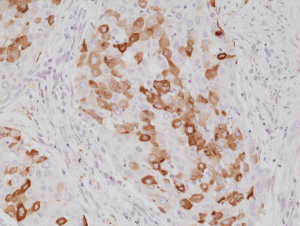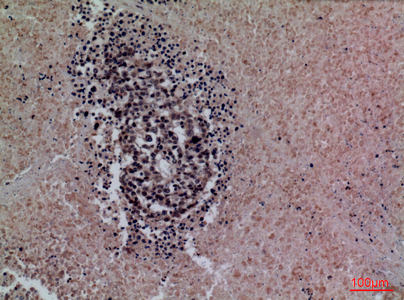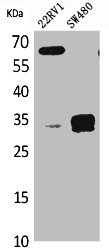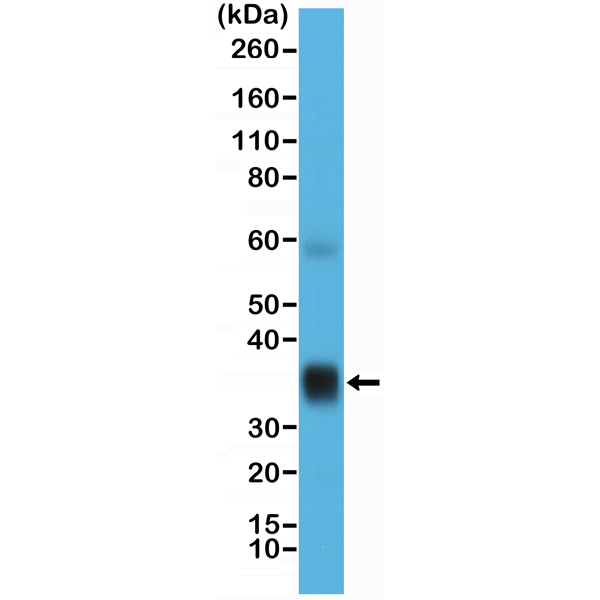
Immunohistochemical staining of formalin fixed and paraffin embedded human lung cancer tissue section using anti-Surfactant protein A (SP-A) rabbit monoclonal antibody (Clone RM334) at a 1:1000 dilution.
anti-Surfactant protein A (human), Rabbit Monoclonal (RM334)
REV-31-1221-00
ApplicationsWestern Blot, ImmunoHistoChemistry
Product group Antibodies
ReactivityHuman
TargetSFTPA2
Overview
- SupplierRevMAb Biosciences
- Product Nameanti-Surfactant protein A (human), Rabbit Monoclonal (RM334)
- Delivery Days Customer10
- ApplicationsWestern Blot, ImmunoHistoChemistry
- CertificationResearch Use Only
- ClonalityMonoclonal
- Clone IDRM334
- Gene ID729238
- Target nameSFTPA2
- Target descriptionsurfactant protein A2
- Target synonymsCOLEC5, ILD2, PSAP, PSP-A, PSPA, SFTP1, SFTPA2B, SP-2A, SP-A, SPA2, SPAII, pulmonary surfactant-associated protein A2, 35 kDa pulmonary surfactant-associated protein, alveolar proteinosis protein, collectin 5, surfactant, pulmonary-associated protein A2A
- HostRabbit
- IsotypeIgG
- Protein IDQ8IWL1
- Protein NamePulmonary surfactant-associated protein A2
- Scientific DescriptionRecombinant Antibody. This antibody reacts to human Surfactant protein A (SP-A). Applications: WB, IHC. Source: Rabbit. Liquid. 50% Glycerol/PBS with 1% BSA and 0.09% sodium azide. Surfactant protein A (SP-A) is an abundant, phospholipid-associated protein in pulmonary surfactant. SP-A is expressed primarily by type II and bronchiolar cells in the respiratory epithelium. In the alveolus, SP-A forms large oligomers and is closely associated with tubular myelin, the major extracellular form of surfactant. SP-A contains a 10-kDa collagen-like amino-terminal domain and a globular carboxyl-terminal domain with structural homology to SP-D, mannose binding protein, Clq, and other members of the collectin family of mammalian lectins. Together with SP-D, SP-A plays an important role in pulmonary innate immunity by recognizing canonical patterns on microbial surfaces. These host defense proteins protect the lung from infection by recognizing the carbohydrate and/or lipid component on pathogens, including bacteria, virus and fungi, and by helping to initiate various clearance mechanisms. It was shown that SP-A activates alveolar macrophage metabolism, and enhances the uptake of bacterial pathogens by both macrophages and monocytes. In addition, SP-A has been shown to serve as a hormone in parturition through its ability to modulate proinflammatory cytokine production, as well as in several other functions which include enhancing phospholipid uptake, inhibiting surfactant secretion by isolated type II epithelial cells, contributing to tubular myelin formation, enhancing surfactant spreading, stabilizing phospholipid mixtures and conferring resistance to protein mediated inactivation of surfactant. SP-A polymorphisms play a role in respiratory distress syndrome, allergic bronchopulmonary aspergillosis and idiopathic pulmonary fibrosis. The levels of SP-A are decreased in the lungs of patients with cystic fibrosis, respiratory distress syndrome and further chronic lung diseases. The interaction of SP-A with type II cells is a receptor-mediated process. - Surfactant protein A (SP-A) is an abundant, phospholipid-associated protein in pulmonary surfactant. SP-A is expressed primarily by type II and bronchiolar cells in the respiratory epithelium. In the alveolus, SP-A forms large oligomers and is closely associated with tubular myelin, the major extracellular form of surfactant. SP-A contains a 10-kDa collagen-like amino-terminal domain and a globular carboxyl-terminal domain with structural homology to SP-D, mannose binding protein, Clq, and other members of the collectin family of mammalian lectins. Together with SP-D, SP-A plays an important role in pulmonary innate immunity by recognizing canonical patterns on microbial surfaces. These host defense proteins protect the lung from infection by recognizing the carbohydrate and/or lipid component on pathogens, including bacteria, virus and fungi, and by helping to initiate various clearance mechanisms. It was shown that SP-A activates alveolar macrophage metabolism, and enhances the uptake of bacterial pathogens by both macrophages and monocytes. In addition, SP-A has been shown to serve as a hormone in parturition through its ability to modulate proinflammatory cytokine production, as well as in several other functions which include enhancing phospholipid uptake, inhibiting surfactant secretion by isolated type II epithelial cells, contributing to tubular myelin formation, enhancing surfactant spreading, stabilizing phospholipid mixtures and conferring resistance to protein mediated inactivation of surfactant. SP-A polymorphisms play a role in respiratory distress syndrome, allergic bronchopulmonary aspergillosis and idiopathic pulmonary fibrosis. The levels of SP-A are decreased in the lungs of patients with cystic fibrosis, respiratory distress syndrome and further chronic lung diseases. The interaction of SP-A with type II cells is a receptor-mediated process.
- ReactivityHuman
- Storage Instruction-20°C
- UNSPSC12352203




